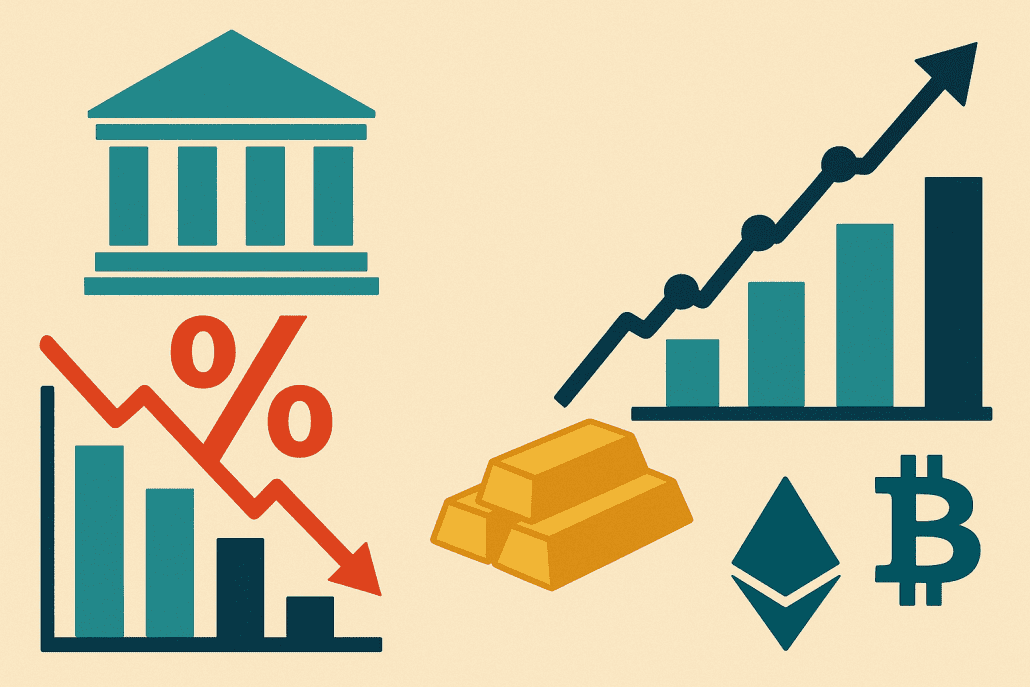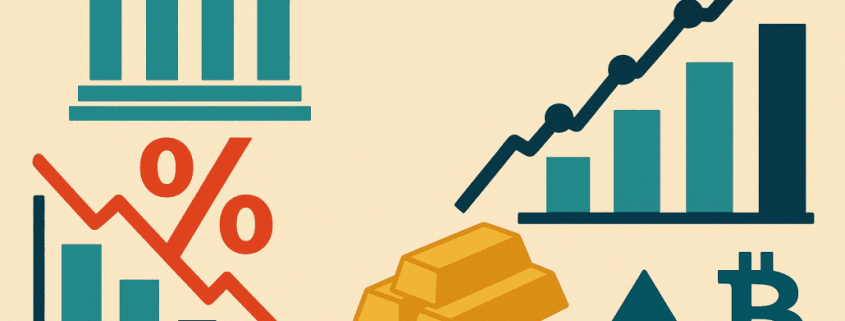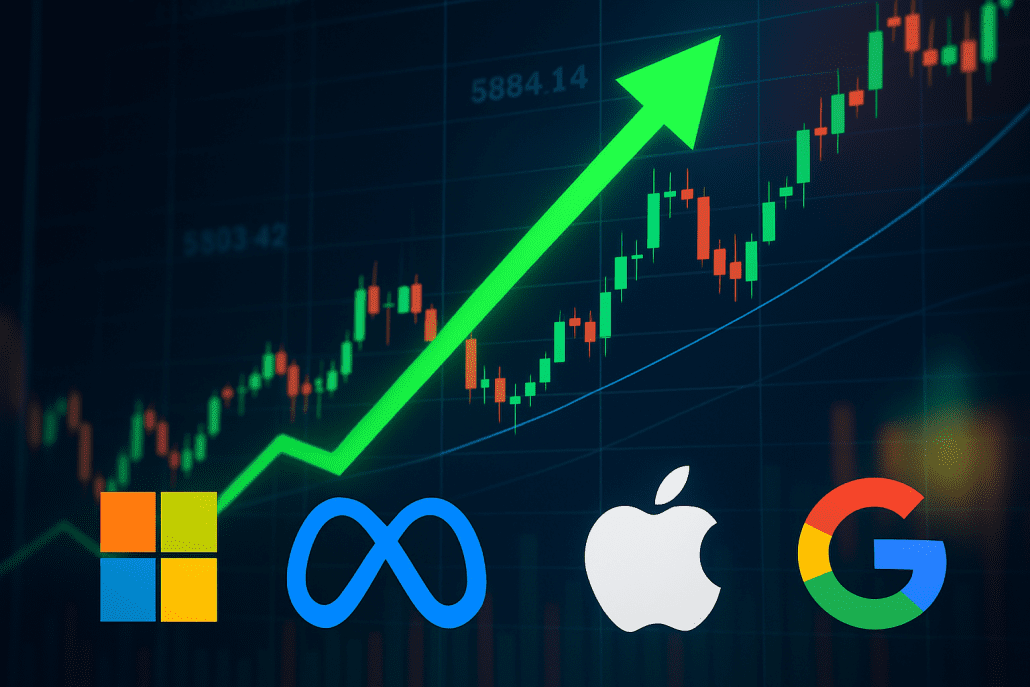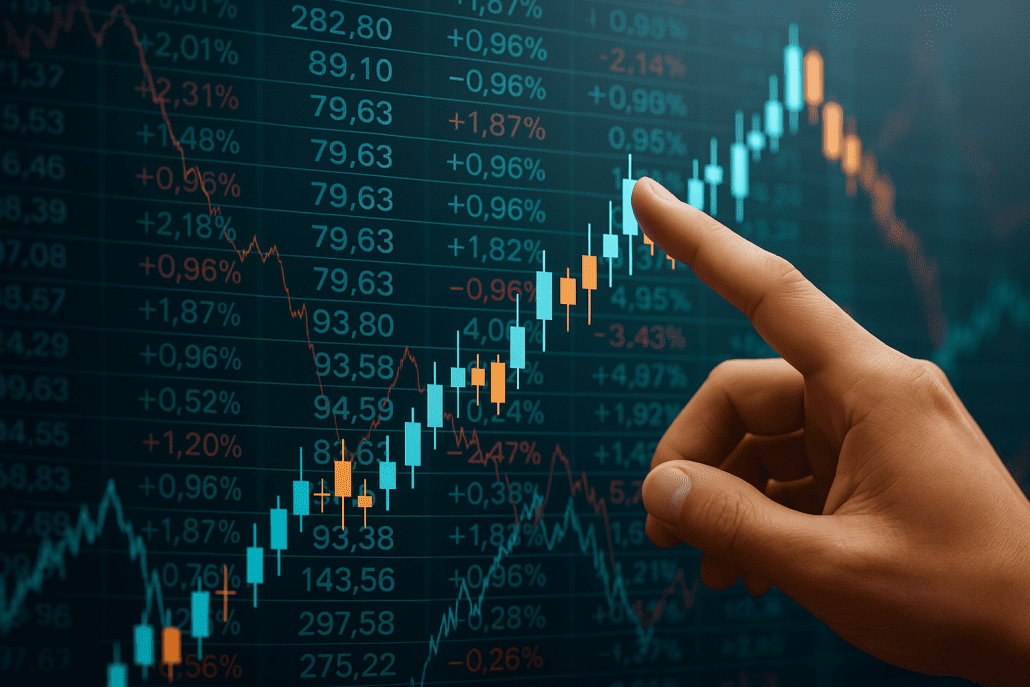Monthly Market Wrap (August 2025)
Market AnalysisJoin our Telegram channel for more market analysis & trading tips: t.me/synapsetrading

Table of Contents
Global Stock Market Trends
August 2025 extended the equity rally, with U.S. stocks posting a fourth consecutive monthly gain. The S&P 500 rose roughly 2.2% for the month, reaching new all-time highs by late August. The Nasdaq Composite also climbed (about 3%), powered by continued enthusiasm for tech and AI-focused names. Notably, the market’s leadership began to broaden beyond the “Magnificent Seven” mega-cap tech giants.
While companies like Nvidia, Microsoft, and Meta Platforms hit record valuations, smaller-cap and cyclical stocks played catch-up. The Russell 2000 small-cap index surged to its highest level of 2025, outperforming large-caps as investors rotated into beaten-down sectors. This “great rebalancing” saw strong rallies in financials, industrials, and consumer discretionary stocks, areas that had lagged earlier in the year.
Overseas markets mostly followed Wall Street’s lead. Major European indices notched modest gains, supported by easing policy uncertainty and a weaker dollar. Germany’s DAX and France’s CAC hovered near multi-year highs as recession fears ebbed.
In Asia, Japan’s Nikkei continued its stellar run, buoyed by corporate reforms and yen weakness, and remained near 30-year highs. In contrast, Chinese stocks lagged. China’s CSI 300 index was flat to down amid signs of economic strain and only cautious stimulus measures from Beijing. China’s economy grew about 5.2% in Q2 (on target), but persistent property sector woes and deflationary pressures weighed on investor sentiment. Overall, global equities in August showed resilience, with the U.S. leading and other regions advancing more selectively.
Macroeconomic & Central Bank Developments
United States: Economic data painted a picture of a slowing but still-growing economy. The labor market showed clear signs of cooling. The July nonfarm payrolls increase (reported in early August) was one of the weakest in years (well under 50,000 jobs), and the unemployment rate edged up to about 4.2%. Inflation continued to moderate despite new import tariffs pushing up certain prices.
The Fed’s preferred core PCE inflation held around 2.9% annualized, near target but still slightly above. Critically, the U.S. Federal Reserve held its benchmark interest rate steady at 4.25% to 4.50% during its late-July meeting, the fifth consecutive hold. Fed Chair Jerome Powell initially struck a cautious tone, emphasizing that inflation, while down from its peak, was “somewhat elevated” and that the Fed needed to see more evidence of cooling prices and wage pressures. This hawkish stance earlier in the summer had dampened expectations of any quick rate cuts.
However, by late August the script flipped. At the Fed’s annual Jackson Hole symposium on Aug 22, Powell opened the door to a possible interest rate cut at the upcoming September FOMC meeting. He noted that downside risks to employment were rising and said the Fed would “proceed carefully” given a shifting balance between inflation and growth risks. While stopping short of an explicit promise, Powell’s dovish hints caused markets to rapidly price in a September rate reduction.
Futures implied roughly an 85 to 90 percent chance of a quarter-point cut in September, up from about 75 percent before his speech. Fed officials echoed this tilt. Even traditionally hawkish Governor Waller stated he fully expects multiple rate cuts to begin soon to guard against a sharper slowdown. In response, U.S. Treasury yields fell in late August, the 10-year yield dipped toward about 4.2% after having hit 4.4% earlier, and the dollar weakened notably. The dollar index ended August down about 2% for the month, reflecting anticipated Fed easing. By month’s end, an interest rate cut on Sept. 17 was widely seen as imminent, which would mark the Fed’s first cut of the cycle after holding rates steady all year.
International: Other central banks were also in cautious mode. The European Central Bank, which had aggressively eased policy over the past year, kept its key interest rate unchanged at 2.00% at the July 24 meeting. With Eurozone inflation back near the 2% target and growth holding up, the ECB opted to pause and assess, marking the end of a string of rate cuts. ECB officials signaled a meeting-by-meeting approach going forward, monitoring risks from the U.S. trade conflict and energy prices.
Late-August data showed mixed inflation across Europe. For example, France’s CPI came in a tad lower than expected at 4.8% year on year, while Spain’s was steady around 2.7%. The Bank of England similarly left rates unchanged (at 4.50%) as UK inflation continued to recede from double-digits to mid-single digits. In Japan, the Bank of Japan maintained its ultra-easy stance, though speculation grew about a tweak to yield-curve control later in the year if inflation, now around 3%, stayed above target.
China’s economic momentum, meanwhile, faltered further, prompting hints of stimulus. August data indicated sluggish consumer spending, falling exports, and outright deflation in consumer prices (China’s CPI was about –0.3% year-on-year). The People’s Bank of China injected liquidity but surprisingly kept its benchmark 1-year Loan Prime Rate at 3.0% in the August fixing, the third straight month unchanged. Policymakers favored targeted support such as bank loan relief and modest fiscal measures over across-the-board rate cuts, wary of capital outflows and yuan depreciation. Nonetheless, Beijing signaled readiness to ease more if needed.
For example, state banks cut mortgage rates for existing borrowers and regulators reduced some trading fees to prop up equity markets. Markets are now anticipating a possible 10 to 20 bps PBoC rate cut by fall if China’s housing slump and deflation persist. In sum, globally the stage is set for a more accommodative turn in monetary policy, led by the Fed’s pivot toward rate reductions as inflation comes under control.
Trade War and Political Developments
Geopolitical and policy news once again had outsized market impact in August. Foremost was the implementation of sweeping U.S. tariffs that President Donald Trump had threatened earlier in the summer. On August 1, the U.S. allowed a temporary tariff reduction deal to expire, ushering in a new “universal” tariff regime on imports. As of early August, countries without a bilateral trade pact with the U.S. face steep reciprocal tariffs, a minimum 15% duty on goods from countries with which the U.S. runs a trade deficit, and 10% on those with a surplus, with many nations subject to much higher rates.
A chart of the finalized tariff schedule showed U.S. import duties jumping to levels unseen in decades. For example, imports from the EU are now generally hit with 15% tariffs, up from low-single digits before. Canada faces a 35% tariff on non-USMCA-compliant goods, and Brazil a massive 50% tariff on most products. Other countries from Asia to Africa saw tariff rates ranging from 19% to 30% or more. These tariffs took effect throughout early August, most by Aug 7, sending shockwaves through supply chains and raising fears of stagflation, higher prices and slower growth.
That said, intensive last-minute negotiations helped soften some blows. The White House secured framework trade deals or temporary exemptions with several partners just before the deadline. Notably, China received an extension of its tariff truce. The 10% duty on Chinese imports was temporarily extended past Aug 12 instead of jumping to a higher rate. This signaled ongoing U.S.–China talks and likely reflected Beijing’s commitment to purchase U.S. goods.
Likewise, the U.S. and European Union reached an in-principle understanding to avoid the harshest tariffs. While EU exports now see that flat 15% tariff, this was considered preferable to the 30 to 50 percent blanket tariffs threatened earlier. Mexico and a few others were granted short extensions or special terms as deals neared completion. These developments eased some investor anxiety that the trade war would spiral further. By mid-month, markets had largely priced in the new tariff reality, though companies exposed to import costs warned of margin pressures ahead.
On the domestic political front, an extraordinary battle over Federal Reserve independence made headlines. In late August, President Trump attempted to fire Fed Governor Lisa Cook, a Fed official who had opposed his calls for immediate rate cuts. This unprecedented move, the President has no clear authority to remove a Fed governor without cause, sparked a legal showdown. Cook sought a court injunction to block her ouster.
A federal judge expedited hearings on the case, which raised constitutional questions and rattled markets. Investors worried that politicizing the Fed could undermine confidence in U.S. monetary policy. The episode, alongside Trump’s persistent public attacks on Fed Chair Powell, underscored an unusual degree of political interference in central banking. While the Fed’s independence so far remains intact, the specter of Trump reshaping the Fed Board added a layer of uncertainty.
Geopolitically, the Russia–Ukraine war escalated in late August. In the pre-dawn hours of Aug 28, Russia launched one of the most intense missile and drone barrages on Kyiv of the year, killing at least 21 civilians. Ukraine retaliated with drone strikes on targets inside Russia, including two oil refineries. The White House said President Trump was “not happy” about the Russian attack and promised a response. He publicly weighed “very serious” new sanctions on Moscow and privately pressed NATO allies to tighten the economic noose.
The U.S. also doubled tariffs on imports from India (to 50% on certain goods) as punishment for New Delhi’s continued purchases of Russian oil. These actions highlight how trade policy is being used as a geopolitical tool. The market impact of the war flare-up was most visible in energy prices, but overall stock indexes showed only brief jitters. Elsewhere, the Middle East remained comparatively quiet, a welcomed change after the Iran-Israel conflict that flared in June. OPEC kept a low profile aside from its scheduled output decisions. And in U.S. domestic politics, early jockeying for the 2026 presidential race began, but with no major policy shifts yet, markets focused more on the trade war and Fed developments.
Corporate Earnings and Stock Market Movers
August saw the tail end of the Q2 corporate earnings season, with a mix of standout beats and notable misses affecting individual stocks. Broadly, earnings were better than feared, helping drive equity gains. By late August, over 85% of S&P 500 companies had reported, with roughly 80% beating analysts’ estimates, reflecting resilient profitability even amid higher costs. However, investors rewarded and punished companies in dramatic fashion based on forward outlooks:
-
Nvidia (NVDA): The AI-chip titan delivered another strong quarterly report in late August. Revenue for the quarter (May to July) surged over 50% year-on-year, handily topping expectations. Nvidia cited booming demand for its GPUs in data centers and AI applications. The stock, which had already skyrocketed in 2025, initially jumped to new highs above $600 after earnings. Yet, in a sign of lofty expectations, NVDA shares fluctuated after the results and ended the next day down about 2% as some investors took profits. Even so, Nvidia remains up about 35% year-to-date and is the world’s most valuable company by market cap, about 8% of the entire S&P 500. Its report was seen as a barometer for the sustainability of the AI-driven tech rally.
-
Retail Giants (Walmart & Target): U.S. consumer spending trends were in focus with big retailers reporting. Walmart (WMT) announced a solid Q2, with revenue up about 5% to $161 billion and improved full-year guidance. However, its earnings per share came in a few cents below consensus. Walmart cited slight margin pressure from shoplifting and higher labor costs. The stock had rallied into the report and then slipped about 3 to 4 percent afterward. Investors seemed to have expected an even stronger showing given Walmart’s position to benefit from consumers trading down to discounters.
Target (TGT), on the other hand, continued to struggle. It reported a 0.9% drop in Q2 sales amid weak traffic and lingering consumer backlash to earlier controversies. Target’s EPS of $2.05 beat a low bar by a penny, but its cautious outlook (and a leadership transition underway) spooked the market. Target shares initially plunged 7 to 10% on the release, though they later recovered some losses. Year-to-date, TGT remains deep in the red as the retailer works to regain momentum.
-
Tech & Growth: With most Big Tech having reported in July, August’s notable movers were in software and internet. Salesforce (CRM) beat estimates and raised guidance, capitalizing on enterprise demand for AI-related offerings. Its stock jumped about 6% post-earnings to 52-week highs. A major highlight was MongoDB (MDB), the cloud database company, which skyrocketed 38% in one day after massively hiking its profit forecast. This double-digit surge made MongoDB one of the month’s top gainers in the NASDAQ 100.
Similarly, Snowflake (SNOW) and other high-growth software names rallied on results indicating steady customer growth despite macro headwinds. On the flip side, some tech high-fliers stumbled. Intel (INTC) gave back about 8% over August as its outlook disappointed (PC demand remains soft), and Apple (AAPL) traded choppily. Its stock was flat for the month as investors await the fall product launch cycle.
-
Industrials & Energy: Old-economy sectors saw significant stock-specific action. Boeing (BA) climbed to a 1-year high after announcing an uptick in aircraft deliveries and positive free cash flow, suggesting its turnaround is taking hold. Caterpillar (CAT) shares jumped about 9% in August, buoyed by strong construction equipment sales and China stimulus hopes.
In energy, ExxonMobil (XOM) popped mid-month on rumors it is exploring a mega-acquisition of a shale producer, part of a wave of consolidation in oil and gas. Meanwhile, European oil major BP saw its U.S.-listed shares retreat a bit after June’s takeover speculation cooled. No deal materialized in August, and BP gave a somewhat cautious outlook. One notable loser was Occidental Petroleum (OXY), down about 6%, after earnings missed and it disclosed a pause in buybacks. Even Warren Buffett’s continued buying of OXY shares could not buoy the stock this month.
-
Notable Collapses: August had a few collapsing stocks that served as cautionary tales. Dollar Tree (DLTR), a discount retailer, plunged 12% in a day after slashing its profit forecast due to rising theft (shrink) and the need to cut prices. Hawaiian Electric (HE) shares lost nearly half their value (and were halted multiple times) amid allegations that its equipment sparked Maui’s devastating wildfires, a potential PG&E-like liability scenario. Also, troubled regional bank PacWest saw its stock dive about 20% early in the month before a planned acquisition by Banc of California stabilized its fate. These episodes underline that even in a rising market, idiosyncratic risks such as legal, regulatory or execution issues can trump broader trends.
In aggregate, Q2 earnings growth for the S&P 500 turned slightly positive, snapping the earnings recession of prior quarters. Profit margins have proven durable, and sectors like tech and consumer discretionary delivered particularly robust results. The earnings-fueled optimism helped the S&P 500 overcome macro worries in August. Still, traders remain discriminating. Blowout results led to outsized one-day pops of 10% or more, while any misses or weak guidance were severely punished, with double-digit drops common. This high dispersion environment created rich trading opportunities over the month.
Commodities, Bonds, and Other Assets
The macro cross currents in August drove significant moves in commodities and fixed income markets:
-
Oil: Crude oil prices swung on geopolitical news and OPEC plus supply decisions. In the first half of August, oil was under pressure. Brent dipped into the low 70s and WTI into the low 60s per barrel amid concerns of softer demand, a late summer U.S. inventory build, and the announcement that OPEC plus would raise output by 547,000 barrels per day in September. However, the end of month flare up in Russia Ukraine fighting sent oil sharply higher. After Russia’s late August missile strikes on Ukraine and talk of new sanctions, Brent spiked back up to about 69 dollars and WTI to about 65 dollars by August 28. The weaker U.S. dollar provided a tailwind to oil prices in the final days. Overall, Brent and WTI each ended August roughly 3 to 4 percent higher for the month. Energy equities responded accordingly, with the S&P 500 Energy sector up about 9 percent, making it the top performing sector in August.
-
Gold and Precious Metals: Gold continued to shine as a safe haven and inflation hedge. The price of spot gold hovered near all time highs in August, trading around 3,300 to 3,400 dollars per ounce. That is roughly a 25 percent gain year to date. Factors lifting gold included expectations of Fed rate cuts and persistent central bank buying. By mid month, gold briefly tested the 3,400 level, and some analysts see 3,500 and above on the horizon if the dollar slides further. Silver also rallied, ending around 37 dollars per ounce, its highest in several years. Notably, despite the risk on mood in equities, gold’s strong performance suggests a subset of investors is still hedging against potential turbulence.
-
Bonds: Bond markets were whipsawed by shifting rate expectations. Early in August, yields ticked higher. The 10 year U.S. Treasury yield approached 4.4 percent, a level last seen in late 2024, amid heavy Treasury issuance and no concrete Fed easing yet. The curve remained steeply inverted, the 2 year vs 10 year spread around minus 50 basis points, for much of the month, signaling growth concerns. However, once Powell indicated a likely rate cut, yields fell markedly. The 10 year yield ended around 4.25 percent, about 15 basis points lower than late July. The more Fed sensitive 2 year yield dropped even more, sliding toward 3.7 percent, its lowest since early spring. This caused a modest steepening of the yield curve by month end as short rates fell on easing bets. In credit markets, investment grade and high yield credit spreads tightened to multi month lows, reflecting investors’ risk appetite. Companies rushed to issue debt ahead of potential Fed cuts, resulting in one of the busiest Augusts for U.S. corporate bond issuance in over a decade.
-
Foreign Exchange: Currency movements in August were dominated by the weakening U.S. dollar. The dollar index fell about 2 percent in August, its fourth straight monthly decline. The prospect of Fed rate cuts reduced the dollar’s yield appeal. The euro gained roughly 2.3 percent against USD, hitting about 1.17 dollars. The British pound climbed to about 1.35 dollars. Emerging market currencies enjoyed a breather thanks to the dollar’s retreat. Notably, the Japanese yen was an outlier. It weakened beyond 147 per dollar at one point, a 2.5 percent monthly loss for the yen, prompting speculation of possible intervention. The Chinese yuan also remained soft around 7.3 per USD, though measures by the PBoC slowed its decline.
-
Other commodities: Industrial metals saw mixed trends. Copper traded range bound around 4.00 dollars per pound. Hopes of Chinese stimulus gave it a mid month pop above 4.10, but lackluster China PMI data later pulled it back. Aluminum rose about 5 percent on supply curbs in China due to power shortages. Agricultural commodities had an eventful month. Grain prices spiked after Russia exited the Black Sea grain deal and bombed Ukrainian ports, then partially retreated as Northern Hemisphere harvests came in strong. Chicago wheat still ended about 8 percent higher in August. Corn and soybeans were more subdued, with decent U.S. crop conditions balancing out weather concerns.
August’s broad theme was one of reduced pressure. Lower yields and a softer dollar provided relief across many asset classes. Commodities like oil and gold benefitted from the dollar weakness and specific geopolitical catalysts. Investors appear to be positioning for an inflection point in global monetary policy as we head into the fall.
Cryptocurrency Highlights
The cryptocurrency market built on its summer surge, with August bringing new milestones for the two largest digital assets:
-
Bitcoin (BTC): The flagship crypto extended its 2025 rally to fresh all time highs. Early in the month, Bitcoin confidently broke above the 120,000 dollar level for the first time. On August 14 it reached about 124,000 dollars, a record intraday high. At that price, BTC’s market capitalization around 2.4 trillion dollars exceeded the market cap of Alphabet, making Bitcoin one of the top four most valuable assets in the world. Drivers included continued inflows into U.S. spot Bitcoin ETFs and a weakening dollar with imminent Fed rate cuts. By late August, Bitcoin saw some profit taking and pulled back to the low 120Ks from its mid month peak. Dips were met with buying, and BTC held firmly above the psychological 115K level throughout the month. Its dominance in the overall crypto market rose to about 50 percent.
-
Ethereum (ETH): Ethereum had an outstanding August and in many ways outperformed Bitcoin. ETH started the month around 3,500 dollars and by mid August smashed through the 4,000 barrier for the first time since 2021. It continued to grind higher, hitting approximately 4,800 dollars at its peak late in the month. That price is just shy of Ethereum’s all time high near 4,865 set in late 2021. Strength came from a booming layer 2 ecosystem, anticipation of a possible Ethereum ETF approval with decisions expected in October 2025, and rotation by investors who felt ETH had been lagging BTC year to date. After trailing in the first half, ETH jumped roughly 55 percent in July and another 15 to 20 percent in August, far outpacing BTC over the summer. By end of August, ETH was trading near 4,700 dollars and was up roughly 35 percent for 2025 to date. One caveat: on chain metrics such as DeFi total value locked and NFT volumes, while improved, have not skyrocketed to new highs alongside price. Still, ETH’s resurgence narrowed Bitcoin’s performance gap.
Crypto market breadth was positive as well. The total crypto market cap rose above 4 trillion dollars for the first time in history. Several altcoins had strong months. XRP rallied more than 20 percent on optimism for regulatory clarity. Solana and other smart contract platform tokens jumped 15 to 25 percent as traders hunted catch up trades after ETH’s run.
Even meme coins saw renewed life. Dogecoin jumped back above 0.22 dollars at one point on speculation of a potential social media integration, and Pepe Coin more than doubled at one stage before volatile trading trimmed gains. The broad altcoin rally gave the market an alt season vibe by mid month, though by late August Bitcoin’s dominance crept up again as traders rotated back to the majors.
On the regulatory and infrastructure front, the SEC delayed decisions on several Ethereum ETF applications to October 2025. Traditional financial giants pushed further into crypto, with new custody offerings and stablecoin rollouts. Liquidity improved compared to earlier in the year, bid ask spreads tightened, and open interest in Bitcoin futures reached record highs. Volatility remained elevated, with brief but sharp squeezes reminding traders how quickly the asset class can move.
All told, August was one of the most bullish months for crypto in 2025. Bitcoin solidified its status above 100K, Ethereum closed in on its prior peak, and adoption signals kept building.
Concluding Thoughts
August 2025 capped off a strong summer for financial markets, characterized by a broadening stock rally, cooling inflation, and rising hopes that central banks will pivot to easing. U.S. equities hit record highs on the back of robust earnings and renewed risk appetite, and the rally spread beyond the mega cap tech darlings. Small caps and cyclical sectors came alive, indicating improving market breadth. The macroeconomic backdrop gave investors reason for optimism.
Price pressures continued to abate with U.S. inflation hovering near 3 percent even as growth, while slowing, remained positive. This mix of lower inflation and still decent growth has stoked speculation that the Fed can engineer a soft landing.
Fed Chair Powell’s acknowledgment of rising employment risks and openness to cutting rates marked a turning point in policy tone. Markets swiftly priced in a September rate cut, providing a tailwind to stocks, bonds, and other risk assets. A slew of global central banks are in a similar holding pattern, if not moving toward accommodation. The prospect of lower interest rates and cheaper liquidity is a key reason we saw cyclicals, housing related shares, and emerging markets bounce higher in August.
But risks still remain. The U.S. China trade war escalated to unprecedented tariff levels, which will start filtering through to corporate costs and consumer prices later in the year. Geopolitical tensions are an ever present wildcard that could rattle markets. The Russia Ukraine conflict’s twists continue to influence energy prices and investor sentiment. Additionally, while the Fed seems poised to ease, friction between the White House and the Fed raises uncertainty. Any perceived erosion of central bank independence or policy credibility could spook investors and strengthen safe havens like gold.
Moving into the autumn, investors will be watching for confirmation that inflation stays contained even as tariffs bite, and that growth does not slip too much as monetary policy shifts. If September brings the first Fed rate cut of the cycle, it will inaugurate a new phase for markets. August’s gains have priced in a lot of good news, so follow through will depend on data matching the rosier expectations.
For now, the bulls remain in control. The S&P 500 uptrend is intact, credit conditions are benign, and crypto enthusiasm is back. Caution is warranted given how far and fast risk assets have run, but after navigating a minefield of risks in prior months, markets in August demonstrated resilience and an appetite to ride the potential policy easing wave.
 Our flagship mentoring program is suitable for both beginners and advanced traders, covering the 4 strategies which I used over the past 15 years to build up my 7-figure personal trading portfolio.
Our flagship mentoring program is suitable for both beginners and advanced traders, covering the 4 strategies which I used over the past 15 years to build up my 7-figure personal trading portfolio.
 If you're looking for a reputable brokerage that covers all products (SG stocks, US stocks, global stocks, bonds, ETFs, REITs, forex, futures, crypto) and has one of the lowest commissions, this is what I currently use.
If you're looking for a reputable brokerage that covers all products (SG stocks, US stocks, global stocks, bonds, ETFs, REITs, forex, futures, crypto) and has one of the lowest commissions, this is what I currently use.
After trading for 18 years, reading 1500+ books, and mentoring 1000+ traders, I specialise in helping people improve their trading results, by using tested trading strategies, and making better decisions via decision science.





Leave a Reply
Want to join the discussion?Feel free to contribute!